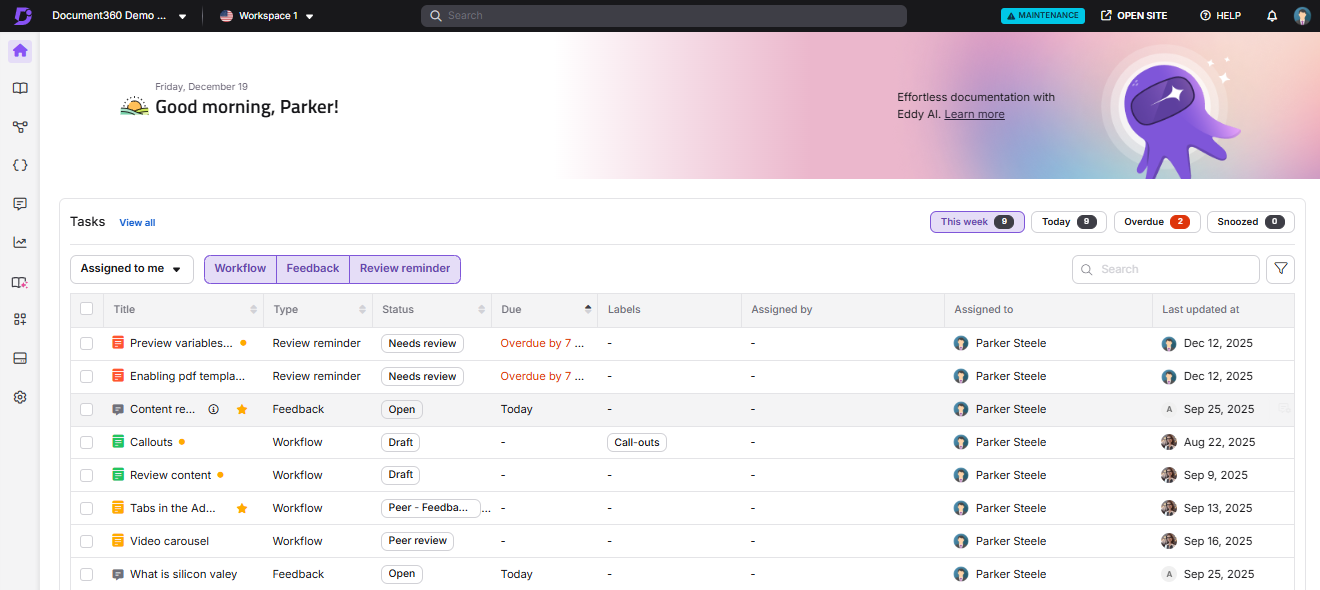DEPRECATION NOTICE
KB Site 1.0 support ends in December 2025. Upgrade to KB Site 2.0 to access new features, enhanced security, and full compliance with WCAG 2.1 AA. Our team will take care of the entire migration for you, requiring no effort on your part.
Document360 v11.12.1 is now live, delivering improvements across analytics, task management, and the KB site experience. This update includes richer Eddy analytics data and UI refinements in KB site 2.0. The release also adds new task management fields, automatic code formatting in the Advanced WYSIWYG editor, and general improvements to list behavior.
Features/Enhancements
Enhanced analytics for Eddy AI search
Category: Analytics | Enhancement
We have introduced updates for Eddy AI analytics to help you understand your audience and content performance more effectively. Eddy AI analytics now captures additional information for every Eddy AI search query. It includes who asked it (email and user group) and when it was asked (date and time), helping you better understand audience intent.
For more information, read the article on Eddy AI search analytics.

KB Site 2.0 enhancements for search, readability, and navigation
Category: KB Site 2.0 | Enhancement
We’ve introduced several updates to improve readability, navigation, and search consistency on the KB site.
When attachments appear in search results, the breadcrumb now includes the article name, so you can see which article each attachment belongs to without opening it.
Text in Chinese, Japanese, and Korean knowledge base sites now display in top-to-bottom mode where applicable.
Center mode under Style layout now expands the article space giving a wider reading area, while reducing sidebar and table of contents width.
All breadcrumb items at the top of each article are now clickable, making navigation smoother.
Auto-collapse can now be configured for the category tree in the knowledge base site. For better use experience, you can enable this setting.
The search bar now appears in the secondary navigation bar, and the filter remains visible in the category tree, even on scrolling.
For more information, read the article on Knowledge base site 2.0.
New columns and filters added to the Tasks page
Category: Tasks | Enhancement
We have updated the Tasks card in the Overview page and the Tasks page to give you better visibility and control over your work. The “Labels”, “Last updated at”, and “Assigned by” columns are now added, making it easier to understand the status and progress of each task. The “Last updated at” field also displays the avatar of the person who made the most recent update, giving you clearer context at a glance.
When viewing snoozed tasks, the Tasks page now shows two additional details: “Snoozed on” and “Snoozed until”. This helps you understand when a task was deferred and when it will return. Since snoozed tasks show only your own items, the “Assigned to” column is removed in that view.
To help you quickly narrow down your task list, the Tasks card now also includes new filters for “Assigned by”, “Last updated at”, “Last updated by”, and “Labels”. These improvements make task management more organized and easier to navigate across all task types.
For more information, read the article on the Tasks page.

Other updates
The code view in the Advanced WYSIWYG editor now automatically formats your content for better readability. When you switch to code view, the editor applies improved indentation and spacing so that the underlying HTML is easier to review and edit. This happens automatically in the background with no additional steps required.
Formatting behavior in ordered and unordered lists has been refined so list numbers or bullets inherit formatting only when it is applied to the entire list item.
NOTE
Minor security updates, bug fixes, and performance improvements have also been implemented across the Knowledge base portal and Knowledge base site.